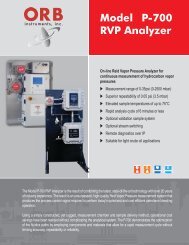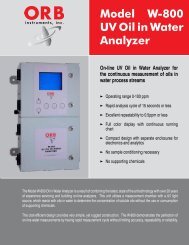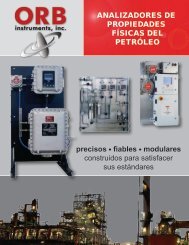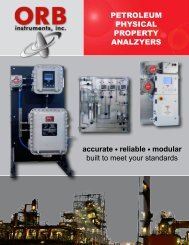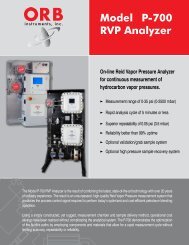Model P-600 SIC Analyzer - OrbInstruments.com
Model P-600 SIC Analyzer - OrbInstruments.com
Model P-600 SIC Analyzer - OrbInstruments.com
- No tags were found...
Create successful ePaper yourself
Turn your PDF publications into a flip-book with our unique Google optimized e-Paper software.
OPERATING PRINCIPLEThe P-<strong>600</strong> Salt In Crude analyzer’s measurement cycle is based on the ASTM Method D 3230. This is done byusing a digitally controlled syringe sample handling system, micro-volume solenoid valves and a measurementchamber equipped with a high-resolution conductivity probe, stirrer and temperature control.First, the sample chamber is emptied by opening the sample drain and the measurement chamber pressurevalve. By utilizing the purge gas, any remaining fluid and vapors are removed. This is followed by a measurementchamber rinsing sequence, where the chamber and stirrer are rinsed and cleaned with Naptha at programmedtimes.Second, the Crude sample loop solenoid is actuated, bringing a precisely measured amount of crude oil intothe tubing path to the measurement cell. Then using the digitally controlled syringe, a precise volume of Xyleneis drawn from a solvent chamber and it is then pushed through the crude sample loop into the measurementcell. Then a precise volume of Alcohol is drawn from a solvent chamber and it is then pushed through the crudesample loop into the measurement cell.Prior to the measurement phase, the stirrer is activated and operated for the duration of the analysis cycle,in order to shorten the analysis time. The measurement chamber temperature is monitored and held at aprogrammed level (normally 45C to 50 C). The analysis is <strong>com</strong>pleted once the sample temperature equilibriumis reached and the conductivity signal has met its stabilization criteria.Once stabilized the conductivity measurement is made, the Salt In Crude level is calculated and reported. Thenthe sample is flushed from the cell and a rinse cycle is initiated to keep the measurement cell clean. After therinse cycle the next cycle can then be started immediately. A delayed mode of operation can also be used tosave on the consumption of solvents.By continuously tracking the conductivity and temperature signals during the analysis cycle, the diagnosticfunction checks the system for abnormal events. The VisioGraph advanced diagnostic routine not onlyprovides end users with immediate knowledge of the condition of the analyzer, it also offers suggestions fortroubleshooting.To further enhance the precision and usefulness of the <strong>Model</strong> P-<strong>600</strong> <strong>SIC</strong> <strong>Analyzer</strong>, an optional validation/grabsample system can be added. This allows the end user to either introduce a reference solution or an unknownsample for immediate analysis. This feature provides a simple system verification or a quick analysis of a nonautomatedsample stream.DIMENSIONS inch (mm)Power In1/2" FPTSolvent TanksCustomerConnections1/2" FPTOptionalPurge ExhaustNaphthaInputXyleneInputAlcoholInputCustomerConnections1/2" FPTMain PowerSwitch73.0(1854)62.0(1568)38.0(965)32.0(813) 26.0(660) 20.0(508)Air In1/2" FPTTo RecoverySystem 1/4" FPTSample Out1/2" FPTSample In1/2" FPTTo AirCoolers36.0(918)54.5(1395)63.0(1610)74.0(1874)30.0(762)37.0(940)



